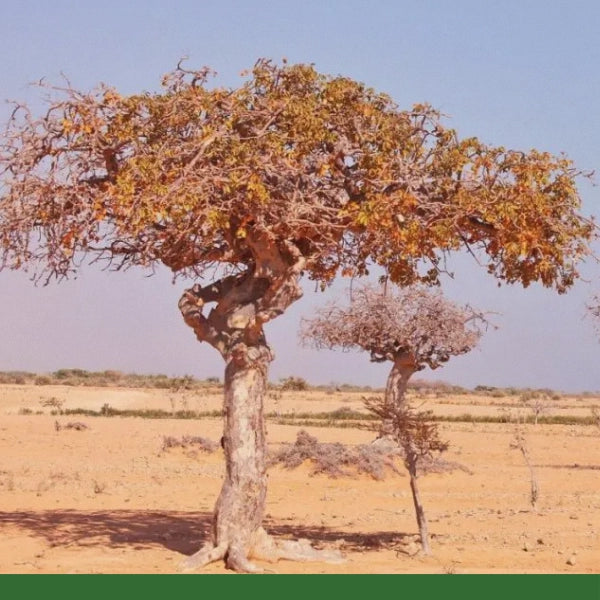Myrrh Gum, Resin (Commiphora molmol) - Dried Herb, Organic
- Regular price
- $26.89
- Sale price
- $26.89
- Regular price
-
- Unit price
- per
Couldn't load pickup availability


Commiphora species are common in the arid regions of tropical and subtropical Africa, Asia and Arabia. Native to Somalia, Oman, Yemen, Eritrea, Ethiopia and parts of Saudi Arabia. Myrrh is a is a deciduous spiny tree or shrubs that grows 9 feet to 12 in height, with small, knotted branches that stand out at right-angles and the trifoliate leaves are scanty, small, unequal, and oval. The Myrrh tree is angiosperm and it has small white flowers with four petals that sprout in panicles at the ends of the branches. The Myrrh tree produces fruit is similar to a small plum with a fleshy outside and a seed in the middle. The flowers are pollinated by small insects, the fruit are eaten by birds and small mammals. Many species of Myrrh have a corkwood bark that stores water in the swollen lower part of their stems and is utilized by animals for the moisture.
Myrrh is a member of the Burseraceae family also known as the torchwood family which consists of both trees and shrubs, including Frankincense. Myrrh Gum is used for traditional medicine and is obtained from a sap-like substance or resin that comes out of the bark when it is cut. This viscous yellow gum then turns into reddish-brown resin when it dries. The name Myrrh comes from the Hebrew "mor", meaning bitterness because the taste of Myrrh is very bitter.
Myrrh has been a spiritual plant in many ancient cultures and was most widely known for its use as incense in religious rituals to anoint kings and scent the fabrics of pilgrims travelling to holy places. It has been used as long ago as 3000 BCE by the Egyptians as an embalming fluid, an incense burned during cremations and funerals and as an ingredient in incense and perfumes. Myrrh once had such great value by the Romans, who prized it as much as gold.
Myrrh was first recognized as traditional medicine in 1822 at Ghizan on the Red Sea coast. Historically, Myrrh was used in Middle Eastern medicine to treat wounds. In Ayurvedic medicine Myrrh has long been used to treat issues with the mouth and throat. And in Chinese medicine, Myrrh (or mo yao) was used for blood circulation, wounds, pain associated with bone, tendon, and ligament pain and painful swellings like hemorrhoids. In folk medicine, Myrrh has been used for colds, coughs, asthma and digestive issues.
Properties:
The taste and energetics of Myrrh are bitter, aromatic, warming and drying. Myrrh has an affinity to the mouth and gums, thyroid, uterus, digestive system, respiratory system, immune system, musculoskeletal system, skin and blood.
How to use:
As an incense burn Myrrh with Frankincense on a charcoal.
Myrrh is best used as an alcohol extract: cover with alcohol in a jar, let sit for four weeks and strain. Take 10 to 15 drops a few times a day, gargle in water or use topically as a liniment.
Cautions & contraindications:
Large doses of myrrh are possibly unsafe in amounts greater than 2-4 grams, because it can cause kidney irritation and heart rate changes.
This information is for educational purposes only and is not intended to diagnose, treat or cure any disease or illness. Please consult your health care provider prior to the use of this product if you are pregnant, nursing, taking medications or have a medical condition. Individual results may vary.

